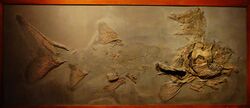Biology:Strongylosteus
| Strongylosteus | |
|---|---|

| |
| Strongylosteus hindenburgi fossil, Staatliches Museum für Naturkunde Stuttgart | |
| Scientific classification | |
| Domain: | Eukaryota |
| Kingdom: | Animalia |
| Phylum: | Chordata |
| Class: | Actinopterygii |
| Order: | Acipenseriformes |
| Family: | †Chondrosteidae |
| Genus: | †Strongylosteus Jaekel, 1931 |
| Species: | †S. hindenburgi
|
| Binomial name | |
| †Strongylosteus hindenburgi (Pompeckj, 1914)
| |
| Synonyms | |
| |
Strongylosteus is an extinct genus of prehistoric ray-finned fish that lived during the early Toarcian age of the Early Jurassic epoch.[1][2] Its type species is Strongylosteus hindenburgi (monotypy). It is related to modern sturgeon and paddlefish (Acipenseroidei), but with a different kind of mouth than common species, made for hunting prey in open waters, with a strong lower jaw, similar to modern beluga sturgeon.
Strongylosteus is a large member of the family Chondrosteidae and the largest non-reptilian marine vertebrate in the Posidonia Shale, with a size between 3 metres (9.8 ft) and 4.5 metres (15 ft), and an estimated weight over 800 kg to 1 tonne.
Strongylosteus has been suggested as a junior synonym of Chondrosteus, although there haven't been any new revisions about the status of the genus.[3]
See also
- Prehistoric fish
- List of prehistoric bony fish
References
- ↑ 1.0 1.1 Sepkoski, Jack (2002). "A compendium of fossil marine animal genera". Bulletins of American Paleontology 364: 560. http://strata.ummp.lsa.umich.edu/jack/showgenera.php?taxon=611&rank=class. Retrieved 2009-02-27.
- ↑ Hennig, E. (1925). Chondrosteus Hindenburgi Pomp.---Ein «Stör» des württembergischen Ölschiefers (Lias\epsilon). Palaeontographica (1846-1933), 115–134.
- ↑ Bemis, William E.; Findeis, Eric K.; Grande, Lance (1997). "An overview of Acipenseriformes". Environmental Biology of Fishes 48 (1–4): 25–71. doi:10.1023/A:1007370213924.
External links
Wikidata ☰ Q7624749 entry
 |




